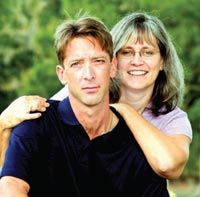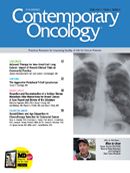Publication
Article
Contemporary Oncology®
Miles for Hope: Cancer Survivor Works to Raise Awareness and Funding for Brain Tumor Research
Author(s):
Bob Gibbs knows the importance of cancer research and the life-saving therapies it creates. The 40-year-old husband and father of 4 would not be alive today without these new discoveries and innovations.

Bob Gibbs knows the importance of cancer research and the life-saving therapies it creates. The 40-year-old husband and father of 4 would not be alive today without these new discoveries and innovations.
In May 2004, Gibbs was diagnosed with an oligoastrocytoma in his right occipital lobe. Given the low grade of his tumor (grade II), he did not qualify for a clinical trial on a groundbreaking cancer vaccine. His only options were surgery, chemotherapy, and the hope that the tumor would not become more aggressive.
DIFFICULT DECISIONS
Gibbs had an initial surgery for removal of a primary brain tumor in 2005, and at that time elected to have only 70% of the tumor removed.
“I wanted to save my vision,” Gibbs recalled. “I wanted to be able to continue to work and provide for my family.” His surgeon did not agree with the plan to partially remove the tumor because he felt that it would just continue to grow. Undeterred, Gibbs’ primary motivation was to provide for his family, so risking potential blindness was not an option for him. Gibbs said, “I felt that if I could get another five years…to earn income to try to get things paid down, it would set my family up” so that they would be financially secure in the event that he did not survive.
So, Gibbs had the surgery to debulk the tumor. Then he and his wife, Barb, spent countless hours researching every possible option and every possible treatment, no matter how early in the clinical trial stage it was. Their research led them to UCLA Medical Center, in Los Angeles, California, where researchers were conducting a phase I clinical trial for DCVax (Northwest Biotherapeutics, Inc, Bethesda, MD), an experimental autologous cellular therapy designed to create a specific immune response against a patient’s cancer cells. The problem was that, given the low grade of his tumor, Gibbs did not yet qualify for the trial.
UNEXPECTED SETBACKS
Making matters worse, 1 year after Gibbs’ initial diagnosis, his 13-year old son was diagnosed with a brain tumor. “We were hit within 363 days of each other,” Gibbs said. “The challenge went from saving my life to trying to save my life and the life of my oldest son.”
Fortunately, his son’s tumor was a vascular type of malformation in the brain and was not cancerous. However, Gibbs’ tumor continued to grow and had progressed into a grade III tumor. This was both bad and good. The advanced tumor stage meant the disease was progressing, however, the grade III tumor had qualified him for the DCVax clinical trial at UCLA.
Both Gibbs and his wife felt that it was ridiculous that patients with brain tumors had to wait for cancer to become more aggressive—to the point at which it could potentially shorten their lives—before qualifying for cutting-edge treatments. “If the vaccine had been available to me…following the first surgery [in 2004], things could have turned out so much differently,” Gibbs said.
MAKING A DIFFERENCE
Four years later, Gibbs and his wife were at their home in Clearwater, Florida. At the time, Gibbs was recovering from his second surgery in 3 years for removal of the brain tumor. Born blind in his left eye, the second surgery left him with only partial vision in his right eye. “I can’t drive, and I’m unable to work,” Gibbs complained. He was outwardly frustrated and depressed.
“This negativity is [getting me] nowhere,” Gibbs said to Barb. “I’ve got to do something.” That drive helped Gibbs and his wife establish Miles for Hope, a nonprofit organization to raise national awareness and funding for cutting-edge cancer research. Getting to that point, however, was no easy ride.
Not wanting to see other patients with brain tumors be denied access to treatments that could make a difference in combating their disease, Gibbs and his wife were determined to bring about a change. They organized the Miles for Hope charity bicycle ride in September 2008. Gibbs noted that, with the exception of their wedding, he and Barb had never organized anything on the scale of this bike ride. Afterward, as they went through the donations, they noticed that several of the checks were made out to Miles for Hope, the name of the event, instead of the research center, UCLA. They were left with two choices: contact the dozens of people who had written the checks or start a nonprofit organization called Miles for Hope. Naturally, they opted for the latter.
“We wanted to fund cutting-edge research,” Gibbs explained. “The biggest thing in dealing with cancer is hanging on to hope that you’re going to survive, that you’re going to find a good treatment.” He pointed out that patients with brain tumors encounter many financial hardships; most focus on the cost of visits to radiation oncologists and neurosurgeons, and chemotherapy copayments, but many tend to overlook the costs associated with transportation to and from the clinical trial sites.
Gibbs said, “We wanted to provide travel assistance so that people could get to these clinical trials, because most of the time [patients with brain tumors] are left financially devastated.” As for his own travel expenses, he added, “If it weren’t for family and friends having the ability to help us with frequent flyer miles, we could never have made multiple trips out to UCLA.”
According to Gibbs, Miles for Hope has become “the little engine that could.” From that first bicycle ride in 2008, the organization now has 10 different events scheduled in 2011 in cities across the country.
Gibbs recalled that it was the thought of his children being without a father that initially drove him to find an acceptable treatment option for his brain tumor. While that has not changed, he is also driven by the people he hears from on a regular basis. “So many people tell me, ‘You’re an inspiration. You give me hope that I can survive, too,’” Gibbs said.
STILL BATTLING
Unfortunately, Gibbs’ tumor has continued to grow. He had gone 2 years without any signs of growth, but a recent MRI uncovered a recurrence. “We were able to catch it early,” he explained, “and I’m back on the vaccine now, as well as chemotherapy. Other than the side effects of the chemotherapy, I feel fine.”
Even as he battles his own health issues, Gibbs manages to remain in good spirits, and somehow maintains a sense of humor despite his present condition. “Every time I make my wife angry, she goes over to my left side and just makes faces, because she knows I can’t see her,” Gibbs explains, laughing. He also continues to work tirelessly to raise awareness and funding for cutting-edge research and clinical trials, and to provide patients with travel assistance. He acknowledges that progress is being made, but he admits that he expects more.
“One thing you have to understand about me is I expect more than I’m able to sometimes physically achieve as one person, or one organization,” Gibbs admitted. “As we see patients continually being diagnosed, patients losing their lives, friends we’ve met, it doesn’t seem like we’re moving fast enough. But, we are making progress. And one day, we’ll be there.”









